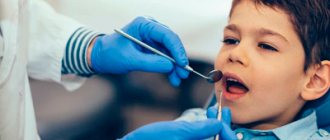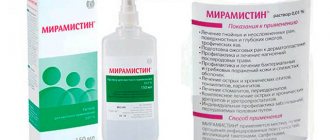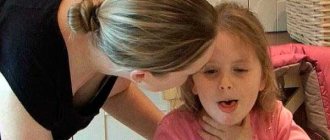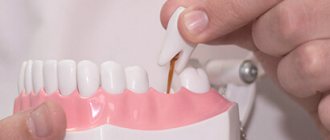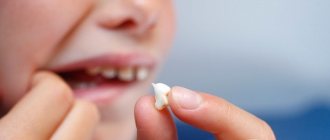- What to do if a child breaks a tooth?
- A child's tooth is dislocated.
- If a child knocks out a baby tooth, what should you do?
- Prevention of childhood dental injuries.
Children differ from adults by being more active and playful.
These properties allow them to quickly understand the world around them. But sometimes children's pranks lead to unpleasant consequences, such as a knocked out or chipped tooth. Injuries to the dentition can occur either due to negligence or as a result of weakening of the enamel. Whatever the reason, parents urgently need to solve this problem.
And the only sure way to avoid complications after a chipped tooth is to see a dentist.
What to do if a child breaks a tooth?
The first thing to do is to calm the child and examine for other injuries that require urgent medical attention. If these are not observed, then rinse your baby’s mouth with water, blot the injury site with a clean napkin, and also try to find the chipped part of the tooth.
If the pain is severe, the child should be given a pain reliever. If a red dot is visible on the tooth, this means that the nerve has been exposed. In this case, you should not give your child cold or hot drinks and go to the dentist as soon as possible.
If there is no red dot on the damaged tooth, it has not moved, and the jaw can close normally, then there is no particular danger. Nevertheless, it is still necessary to see a doctor, since the tooth has lost its protective layer and is now more susceptible to infections and all kinds of diseases. Without proper treatment, the nerve may simply die, resulting in the loss of the entire tooth.
The statistics for permanent teeth are as follows:
If the tooth is returned to its place within 30 minutes, it will take root in 90 percent of cases; if replantation is delayed for up to 2 hours, it will fail in 90 percent of cases. It is clear that during the first 30 minutes, first aid to the injured child will be provided by his parents. According to Polish researchers, the percentage of medical workers willing to replant a tooth at the site of injury is only 7 percent; the rest prefer to call parents to take the child to the dentist. And this is a waste of time, reducing the chance of engraftment.
Therefore, forewarned means forearmed. Tell your friends.
Tooth dislocation in a child
Tooth luxation is a displacement of the crown in its alveolus as a result of physical impact. This injury is especially common in children and is common among all types of dental injuries. Symptoms of a dislocation may include:
- displacement of the dental crown back, forward, sideways
- the tooth is rotated around its axis
- the child cannot close his jaw completely
- tooth tissues are separated from the gums
- the soft tissue around the tooth swells and bleeds
- the tooth is loose, but still stays in the socket
It is imperative to see a dentist, even if the tooth looks almost undamaged. There may be a broken root or damaged nerve inside it. Such a tooth can be saved, the main thing is not to put pressure on it and not to self-medicate.
Only a qualified dentist can correctly assess the damage and prescribe effective treatment. If you see a doctor within the next hour after receiving an injury, the chances of saving the tooth increase significantly.
Why do children break their teeth more often than adults?
It's not just about a more active lifestyle.
Adults also engage in extreme sports, fall, and try to chew something hard with their teeth. It’s just that in children, the erupted permanent teeth are incredibly fragile, the nerve is hidden under a thin layer of hard tissue. Such a tooth needs to mature, strengthen and grow. You will be surprised, but, according to statistics, about a third of people in childhood had the sad experience of broken teeth. Sports, games, fights - the circumstances are different, the result is the same. Do not panic! We will do everything possible to bring the tooth back to life. #treatment
If a child knocks out a baby tooth, what should you do?
In the case of baby teeth, we are not talking about restoring them or putting them back. It is not necessary to look for the knocked-out fragment. But it is necessary to take care of the molar tooth germ, which is located in the gum. You cannot injure it or allow it to get infected, so a visit to the dentist is mandatory.
If the baby accidentally knocks out a molar, it must be found and returned to the socket as quickly as possible. In this case, the tooth should be washed in saline solution or plain water, and also held by the crown part so as not to cause an infection.
The best and most predictable option is to return the tooth to the socket within the first 15 minutes. This increases the chance of its recovery to 90%. If you are afraid to insert a tooth yourself, then you should see a doctor as soon as possible.
In this case, the tooth must be transported in a suitable environment - saline solution, milk, water.
What actions should be taken if a child suffers an injury to a baby tooth?
Let's start with the fact that injury is always pain. It would seem that baby teeth will change anyway... Why pay attention to them? Believe me, it is necessary and necessary to pay attention. If you do not contact pediatric dentistry for treatment of baby teeth, then in the future there is a risk that the infection that has affected the baby tooth will damage the germ of the permanent tooth. If you do not pay attention to the injury of a baby tooth, you may not see the damage in the bud of a permanent one.
Children, by nature, have very mobile and active behavior and lifestyle. This is wonderful! But sometimes they do not hear or perceive the warnings of adults aimed at ensuring safety. This leads to various injuries, often associated with teeth. When the question concerns the injury of a baby tooth, you can often treat the moment negligently with the expectation that it is still temporary and would have fallen out anyway.
Don't leave the situation to chance! Even if the injury affected a baby tooth, which was about to fall out anyway. The fact is that the force of a blow is sometimes impossible to estimate. Under the milk tooth is the germ of a permanent one. It is often impossible to conduct even a visual inspection on your own, not to mention what kind of trauma was caused to the gum and, possibly, the germ of a permanent tooth.
In a situation where there is an injury to a child’s tooth(s):
- Stay calm (although this is sometimes difficult in practice). If you are nervous, children will absolutely sense the mood, especially of loved ones.
- Do not scold your child under any circumstances (“I told you, I warned you!”) Do not forget that he is already in pain and scared. All educational moments and lessons from the situation can be raised later, after the pain has calmed down.
- Show maximum care and tenderness, reassure as much as possible.
- It is imperative to visit a dentist for an examination and consultation and conduct a diagnosis of dental treatment. When you call your clinic or the nearest one (at your discretion), DO NOT ask if a pediatrician is working today, DO NOT say that you need a pediatric dentist. It must be said directly that the child has suffered a tooth injury and needs an urgent examination by a doctor. In every decent clinic they should offer you to come right away, regardless of the doctor’s appointment, and they may warn you that you will have to wait. Or, at a minimum, they are obliged to offer: “wait, I’ll clarify what we can do for you, leave your contact phone number and we will call you back in the next 5-20 minutes.” In this case, they will offer to drive to the clinic or direct you where you can go directly at this moment. If they immediately answer you: “We’re all busy, we can’t help you,” don’t ever go to this clinic.
What the doctor will do at the appointment:
- Visually examine how serious or minor the injury is.
- Be sure to take a photo in the area of the injured tooth(s) to understand whether the permanent tooth(s) are damaged or not.
- He will remove the injured tooth so that it does not cause pain and inconvenience. If the blow was not severe and the tooth was only chipped, if recovery is possible, the pediatric dentist will cure it.
- If necessary, provide recommendations for care in the area of injury.
- As planned, he will make an appointment for the child to be examined by a pediatric dentist if it was not possible to get to him on the day of the injury.
Any experienced dentist will be able to visually and with the help of X-ray diagnostics assess how serious the injury is or whether everything was just a minor fright. Don't leave injuries unattended!
Prevention of childhood dental injuries
In order not to encounter the situations described above, you should take care in advance of the safety of the baby’s oral cavity. Remember that some dental injuries can be prevented by using simple protective measures:
- An excellent protection against injury during active games or sports is a helmet that not only protects the head, but also the teeth.
- To protect your child's teeth, use a mouthguard. This simple dental product provides as much as 85% protection.
- Talk to your children about the importance of being careful when playing. But don't intimidate them.
- Teach your child to fall without injury. Demonstrate how to tuck to avoid head and neck injuries.
- Provide your baby with healthy nutrition with all the necessary vitamins and microelements.
- Teach your child to brush their teeth regularly and visit the dentist every six months.
If you still failed to protect your baby from injury, you should contact your dentist as soon as possible. You can get qualified help at Aesculapius dentistry. In our dentistry you will find first-class equipment and modern treatment methods.
Four specialists work in one shift and they know their job very well. We work with each patient on an individual basis and provide a guarantee for all services. Absolutely all clients are satisfied with the level of service.
What complications can there be?
The main complications of fractures of primary teeth are:
- Formation of a malocclusion (if a broken tooth has fallen out or been removed);
- Pulpitis. Damage to the enamel and tooth crown facilitates the penetration of pathogenic microorganisms into the pulp, where after some time an inflammatory process can develop;
- Periodontal abscess, phlegmon, osteomyelitis and other purulent complications. They are a consequence of advanced infection after tooth trauma.
If a child breaks his molar front teeth, it is important to make sure that the roots of the teeth are not damaged. Injury or fracture of the root of a permanent tooth is dangerous because the tooth may have to be removed from the roots, and expensive implantation will be required to restore the dentition.
What consequences may there be
A piece of teeth knocked out in childhood can lead to the following complications:
- malocclusion: neighboring teeth will shift, preventing the formation of permanent teeth,
- speech defects: their risk especially increases with the loss of incisors, which take an active part in articulation,
- diseases of the digestive tract: the inability to thoroughly chew food leads to its insufficient processing by oral enzymes, swallowing in pieces, which over time provokes gastrointestinal diseases.
Also among the negative consequences can be noted: violation of the aesthetics of the dentition, the appearance of problems in communicating with peers, an increased risk of pathologies in neighboring units, frequent inflammation even after successful treatment.
Maybe leave it as is? The child has no visible injuries
If the baby is not in pain, there is no bleeding and there is no wound on the gum, everything is probably fine. However, only a specialist can accurately determine this.
Possible consequences of dental trauma in children:
- Nerve damage could occur or an invisible crack may appear, which in the future will lead to a fracture of the coronal part.
- A loose tooth needs to be splinted to prevent it from falling out.
- A chipped piece of enamel will expose dentin, which does not always cause pain. But an infection gets into the place of the chip, and this is fraught with the development of pulpitis and periodontitis. In this case, proper treatment of baby teeth will be required.
We care about the comfort of young patients. They leave us happy. If you have any questions, call us.
How are they treated?
The dentist determines treatment tactics depending on the severity of the injury and the condition of the tooth. The following methods are used:
- Tooth restoration. Suitable only in cases where a small piece of the tooth has broken off and the pulp is not involved in the pathological process. Various types of composite materials are used to restore the integrity and normal appearance of the tooth;
- Depulpation. This procedure is used for more severe fractures when the child has symptoms of pulpitis. The process removes the infected pulp, which allows you to save the tooth and prevent the child from developing a malocclusion;
- Delete. A radical measure that is used in cases where it is no longer possible to save the tooth.
How to restore a knocked out tooth
When contacting a dentist, first of all, he will perform an antiseptic treatment of the wound and prescribe an x-ray. Subsequent actions will depend on the nature of the damage.
So, if a tooth is completely knocked out, the doctor can insert it (provided it is intact) in the near future into the hole, ensuring fixation with a splint; if necessary, stitches are placed on the wound. On average, engraftment lasts about two months, during which you will need to regularly visit a specialist. In the future, observation by an orthodontist will be required.
If the tooth “hangs” on the gum, after anesthesia, the doctor carries out appropriate treatment. This could be: suturing a wound, filling canals, fixing a broken part of a crown, and so on depending on the situation. All actions are carried out on the basis of radiographic data.
“When my son broke his upper incisor, the dentist re-seated part of the crown with some kind of compound. For two years we protected this incisor, followed a soft diet and so on. Now it has fallen out safely, and the new one is growing without problems...”
Elizaveta O. (from a message on the woman.ru forum)
Symptoms of a tooth fracture
The fact that a child has broken a tooth is indicated by:
- Changes in tooth size and shape . The tooth may be broken at the root - this is obvious, but part of the crown may also be missing or a small chip may appear. The length of the tooth may decrease compared to other teeth - this indicates the presence of an impacted fracture, when the tooth plunges into the alveolar process.
- Horizontal crack along a tooth . This is a sign of an incomplete fracture. In such cases, the tooth may become loose and when you touch it, acute pain appears.
- Severe pain in a tooth or jaw . Pain in the jaw indicates an impacted fracture.
- Bleeding from the area of a broken tooth . An optional sign, found in complex cases.



